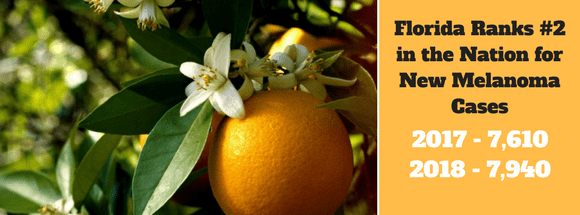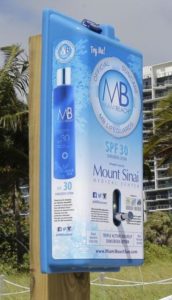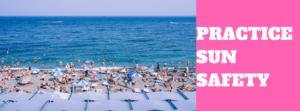Melanoma By The State: Florida

Your Skin in the Sunshine State
While living in Florida has its many benefits ranging from mild winters to an abundance of outdoor opportunities, it also presents dangers to your skin.
- ~Florida ranks second in the nation for the highest rate of new melanoma cases.
- ~An estimated 91,270 cases of melanoma will be diagnosed in the U.S. in 2018. 7,940 are estimated in the State of Florida.
Florida Statistics
- ~Approximately one in ten Floridians have been told they have skin cancer (9.2%).
- ~In Florida, 17% of people reported having a sunburn within the last year, with adults 18-44 years old nearly twice as likely to have a sunburn (33%).
- ~According to a 2015 Youth Risk Behavior survey, nine out of ten public high school students (91.2%) did not wear sunscreen most of the time or always when outside for more than one hour on a sunny day.
- ~The same study showed that 6% of students sought out exposure using an indoor tanning device, such as a sunlamp, sunbed, or tanning booth, one or more times during the past 12 months.
The Florida Cancer Data System (FCDS) provides annual melanoma rates by county and can help determine skin cancer incidence, new cancer diagnosis, and mortality.
How Florida is Raising Awareness and Practicing Prevention
Although Florida continues to have the second highest rate of melanoma cases in the country, it is making significant strides in reducing this number in Floridians.

Sunscreen Dispenser in Miami Beach
In Miami Beach, through the support of an exclusive sponsor, Mount Sinai Medical Center, and supporting sponsor Destination Brands International, 50 sunscreen dispensers were placed at public pools, parks, and various beach access points near lifeguard stands. The dispensers are free to use for all who visit Miami Beach.
Sun’s Up Cover Up, a collaborative project between the Florida Department of Health and the Florida Department of Environmental Protection, was a sun safe awareness pilot project implemented at 10 state parks in May 2015. Park rangers raised awareness on sun-safe behaviors to park visitors by providing 6,000 sunscreen packets, 3,000 lip balms, and 3,000 static cling reminders.

Sun Safety in Florida
The sun in Florida can be quite strong, especially during the summer months. Daily outdoor activity is inevitable for Florida residents and visitors. What can you do to protect yourself against harmful UV sun rays? Here are some tips to help you protect your skin in the sunshine state.
1. Time of day: The hours just before and after midday are most hazardous for UV exposure, generally from 10 am to 4 pm. Avoid outdoor activities during this time, if possible. Practice the shadow rule: if your shadow is shorter than you, the sun’s rays are at their strongest and you should find shade.
2. Minimize direct as well as reflective exposure: To protect against the sun overhead, seek shade as much as possible, whether from a tree, umbrella, or shelter. Be extra careful around water and sand. These surfaces reflect the damaging rays of the sun, which can increase your chance of getting a sunburn.
3. Length of exposure: Damage from harmful rays can occur in as little as 15 minutes of exposure but the longer you are out, the greater the exposure.
4. Clothing: If possible, wear a long-sleeved shirt and long pants. Dark clothing with tightly woven fabric blocks more sun than white or loosely woven fabrics. For additional protection, look for clothes made with special sun-protective materials.
5. Hats: Darker colored, wide-brimmed hats, made of tightly woven fabric like cloth are excellent for covering the face, nose, ears, and neck. Avoid straw hats which may allow UV rays to penetrate through the holes.
6. Sunglasses: Large, wraparound sunglasses provide good protection since they prevent UV rays from entering from the side. Most sunglasses sold in the US protect against both UVA and UVB types of rays, both of which can be harmful.
7. Sunscreen: By reflecting, scattering, or absorbing UV rays, sunscreens are a valuable tool in protecting the skin. Choose a broad spectrum sunscreen that protects against both UVA and UVB radiation. Make sure it is water resistant and has an SPF of 30 or higher.
- ~A half hour before going outdoors, apply sunscreen generously to all exposed skin (for most of us, the suggested amount of lotion is about 1 ounce, which is the same as 2 tablespoons). Then reapply at least every two hours. Don’t forget to apply sunscreen on the face, ears, hands, and lips as well as the rest of the body.
- ~When swimming, reapply much more frequently, even if the sunscreen says that it is waterproof or water resistant.
8. Children: Keep babies younger than 6 months old completely covered and in the shade.
9. Medications: Be even more cautious if you are taking medications that may make you more sensitive to the sun. Those with certain health conditions or on medications including antibiotics, anti-inflammatories, antifungals, blood pressure medications, chemotherapies, and antihistamines may be at an even greater risk.
10. Use sunscreen every day – even if it’s cloudy! According to the CDC, skin damage can occur from as little as 15 minutes of unprotected sun exposure. Overexposure to UV rays can occur not only on hot, sunny days — but on cool, hazy, and cloudy days, as well. (It’s not the temperature that burns your skin, it’s the sun’s invisible ultraviolet radiation.)
All statistical Information provided by Florida’s Comprehensive Cancer Control Program, whose mission is “To protect, promote & improve the health of all people in Florida through integrated state, county, and community efforts.”
Recent Posts

In Plain English: Update on Melanoma Vaccines, 2024

Options For Stage II Melanoma: Making the Decision that’s Right For You

Coolibar’s Generous Donation to the AIM at Melanoma Foundation

Fall 2024 Newsletter


